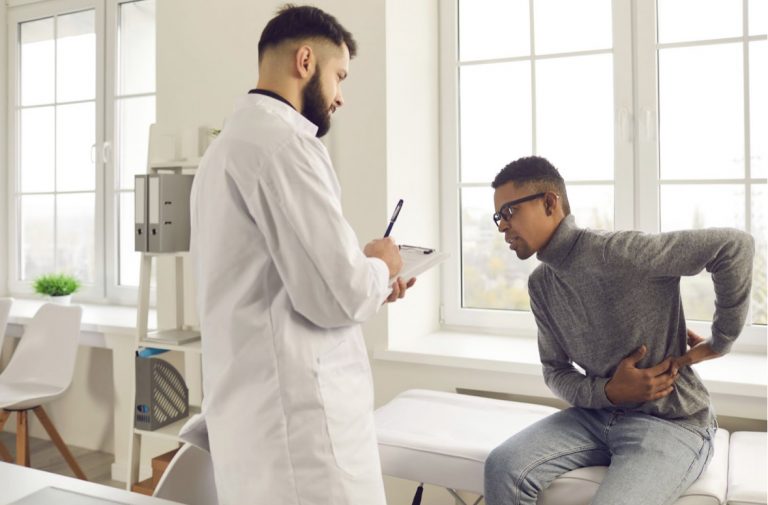Bulging discs occur when a weakened spinal disc bulges out of its normal perimeter in the spine, often due to the natural aging process. When this occurs, it can put pressure on the nerve or spinal cord which sends pain signals along the length of the affected nerve and disrupt the transmission of sensory information. This causes discomfort throughout the body as well as a collection of other symptoms. If you have been diagnosed with a bulging disc, it is likely affecting your time with family, work, and leisure activities.
Symptoms
In order to properly treat bulging discs, it is important to understand the symptoms associated with them so you can identify your most debilitating symptoms. A few of the most common symptoms of a bulging disc include:
- Radiating pain in the legs or arms
- A localized pain in the neck or back
- Muscle weakness or spasms
- Numbness or tingling sensations
Depending on the location of your bulging disc, you may experience your symptoms in different locations. A bulging disc and its symptoms can originate in any of the three regions that have spinal discs. These sections are the cervical spine (neck), the thoracic spine (middle back), and the lumbar spine (lower back).
If you have been diagnosed with a bulging disc, or if you know someone who has, learning more about the condition’s symptoms can let you know what to expect and can help during the treatment process. The following guide is intended to help you better work with a doctor or specialist to develop a care plan to give you the best chance of returning to a healthy, active lifestyle.
Cervical Bulging Disc Symptoms
Cervical (neck) bulging discs are one of the most common causes of neck pain. The cervical area is comprised of the top seven vertebrae in the spine, symptoms of nerve root compression in the cervical spine can include pain, tingling, numbness, and weakness in the neck, shoulders, arms, hands, and fingers, Additionally, individuals with a bulging disc in the cervical region may experience headaches and myelopathy a group of symptoms that includes difficulty walking, feelings of heaviness in the legs and loss of fine motor skills in the fingers.
If you are experiencing any of these symptoms, a cervical disc may be to blame. A few of the most common factors that can contribute to a cervical bulging disc include poor posture, injuries such as whiplash, genetic spinal conditions, and the natural wear and tear that the body endures with age.
Thoracic Bulging Disc Symptoms
The thoracic area of the spine spans from the collar bone to the end of the rib cage and consists of twelve vertebrae. Bulging discs are less common in the thoracic region, but when they do occur, the symptoms can include pain in the upper back that sometimes radiates to the chest or stomach. Additionally, depending on the affected vertebrates, symptoms may also occur in the lower body.
The nature of these symptoms can lead a patient to incorrectly suspect a problem with the heart, lungs, or gastrointestinal tract, so it is important to promptly consult with a physician to obtain an accurate diagnosis.
Lumbar Bulging Disc Symptoms
The lumbar region of the spine spans from the waist to the hips and includes five, sometimes six, vertebrae. Lumbar disc problems are a widespread cause of lower back pain, which can be dull, sharp, or burning and can radiate to the hips, buttocks, legs, and feet. Lumbar bulging discs can also result in muscle weakness, numbness, tingling, muscle spasms, and reduced coordination. While these symptoms are painful as is, they can worsen with coughing, sneezing, and bending over. When a lumbar bulging disc exerts pressure on the sciatic nerve, the resulting symptoms are commonly referred to as sciatica. In rare cases, patients with a lumbar bulging disc might experience a loss of bladder or bowel control. If this happens, the patient should go directly to the emergency room immediately, as bladder or bowel incontinence can indicate cauda equina syndrome, a condition requiring immediate surgery.
Lumbar bulging discs can severely limit your range of motion and impact your quality of life, as this region is responsible for bearing the weight of the upper body and facilitating a variety of everyday movements. To help avoid injury to the lumbar spine, be sure to [practice good posture, engage in regular low-impact exercise, and eat a balanced diet.
BEST Health System
If you are experiencing any of the symptoms associated with a bulging disc, meeting with a doctor early on allows you to treat the condition before it worsens. If you are4 interested in learning more about bulging discs and the symptoms that come with them, reach out to BEST Health System and take the first step towards recovery.
